Electors vote for one candidate under the first-past-the-post voting system, and a winner is determined by who accumulates the most votes. This can often lead to unexpected results. For instance, losing a party seat may not necessarily be proportional to its vote share. If it goes beyond this “voter’s threshold”, a party will get more seats than it deserves; while falling below – sharply reduces the number of seats. It does not consider that one-party cannot secure voters in other means but also through elections. The change from pluralism to dichotomy as well as coalition formation affects how votes are turned into seats too.

BJP The Bharatiya Janata Party secured victory in 2014 while the Congress and the Left were defeated.
During Jan Sangh era (1951-1971) until the first elections of BJP in 1984, it had low vote-to-seat ratio. The party’s vote share has always been higher than its seat share. In 1984, it got 7.4% votes and 0.4% seats. It will start gaining more seats from the following election as it crosses above 11% votes (which is likely to be close to the party’s seat switching threshold).
On the other hand, since 1989, its seat share has always exceeded its vote share. Between 1984 and 2014, its peak was achieved in ‘98-‘99 when there was around a range of about 24-26 percent of vote and about a third of seats. Another great leap happened in ‘14 but yet again this time after that seat share rose by over thirty percentage points: from just over twenty one percent in ’09 to about fifty-two percent in ’14.
Cluster However, Congress is going on another route entirely. In fact, in ’09 it scored a mere fifth below one third of all votes at twenty eight point six percent and won thirty eight point nine four percent seats. During the following parliamentary ballot, there was a loss of almost ten percent for each category with relation to votes gained and congressional representatives elected respectively as these numbers went down with nearly ninety-seven seats lost although they were able to gather almost two out three – which appears less than required for them among others – sitting members after both surveys conducted during last year had established that about twenty per cent figuring seemingly indicates such thing; nevertheless this meant little because they garnered less than half as many places so those figures themselves do seem like really significant signs pointing towards any ground level influence test case regarding power level.
left Between 2004-09, it gained an additional 0.4% vote share and increased its seats by 3.1%, implying that the party’s electoral threshold is between 7 and 8%. The next parliamentary election saw a fall of 0.6 percentage points in the vote share of this political party, but its seat share fell by 6.4 percentage points.
TMC got .4% votes and lost twelve seats…

The voting and seat share of Trinamool Congress reveals an interesting trend. While its voting share increased by 1.1 percentage points between 2004 and 2009, the party’s seat share grew by 3.1 percentage points.
For these elections, which are more contested between the Left, Trinamool and Congress, the party’s threshold is likely to be around 3% of the vote so that there would occur a disproportionate seat gain with a little increase in votes. In West Bengal, elections continue to be highly polarized, perhaps that has heightened the threshold for vote share. When comparing it against the BJP during elections held from 2014 and 2019, its vote count increased by 0.4%, but still registered a fall of -2.2%.
In this case BJD’s vote share remained unchanged but it lost eight seats due to growing competition between parties at both ends of the spectrum.
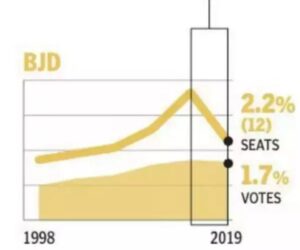
…even though BSP lost by 0.5% but won 10 seats extra.
The Samajwadi Party’s vote share increased a little, however lost 18 seats between the years 2009 and 2014 for the same reason.
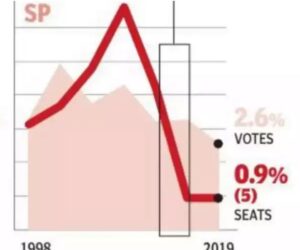
The Philippine central bank’s situation, conversely, is a bit different. It got 4.2% of the total votes in 2014 and had no seat at all. In 2019, its voting shares went down but the seat shares went up. This took place because it was in coalition with the SP and hence it had a lesser number of seats to vie for.
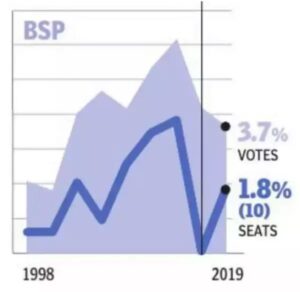
The real swing sultans are fence-riding voters.
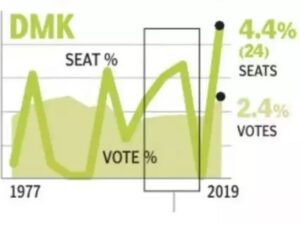
It is true that in some parties such as DMK and ADMK, their loyalists are always loyal to the party despite the vote shares remaining the same yet seats change drastically. This may be due to those voters who sat on the fence without loyalty to either DMK or ADMK but swung their votes differently during various elections. For instance, in the general elections of 2004, 2009 and 2014, the DMK’s vote share remained unchanged at 1.8%, while its number of LS constituencies decreased from 16 through 18 down to zero (in these three elections).
In addition, its voting power grew by an increment of 0.6 percentage points hence increasing its seat strength by about 4.4 percentage points in 2019. Similarly, between 2009 and 2014, there was a rise in ADMK’s vote share by around –+1.6 per cent together with a corresponding increase in seat share of more than +5%.
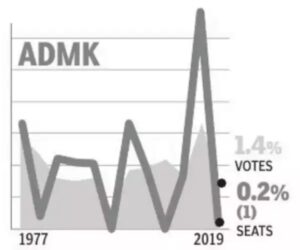








Great post. I am facing a couple of these problems.
I like what you guys are up also. Such smart work and reporting! Carry on the superb works guys I’ve incorporated you guys to my blogroll. I think it’ll improve the value of my website 🙂
I’m really enjoying the design and layout of your website. It’s a very easy on the eyes which makes it much more enjoyable for me to come here and visit more often. Did you hire out a developer to create your theme? Outstanding work!
I’m not that much of a online reader to be honest but your blogs really nice, keep it up! I’ll go ahead and bookmark your site to come back down the road. Many thanks
Very efficiently written information. It will be useful to anybody who usess it, including yours truly :). Keep doing what you are doing – looking forward to more posts.
I am extremely inspired along with your writing abilities as neatly as with the format on your blog. Is that this a paid theme or did you customize it your self? Either way keep up the nice quality writing, it is rare to see a great weblog like this one today..
Good ?V I should certainly pronounce, impressed with your website. I had no trouble navigating through all tabs and related info ended up being truly easy to do to access. I recently found what I hoped for before you know it in the least. Quite unusual. Is likely to appreciate it for those who add forums or anything, website theme . a tones way for your client to communicate. Nice task..